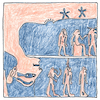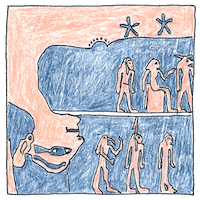Old Kingdom of Egypt
astronomy

|
Egyptian calendar
The Egyptians already had a lunar calendar to define the liturgical year. Their civil calendar based on the heliacal rising of Sirius gave them the ability to predict the flooding of the Nile. Three seasons changed with the behavior of the Nile, each with four months of thirty days. The season of Flood when the Nile floods. The season of Growth when the land emerges and crops are planted. The season of Low Water when crops are harvested. Each month with three weeks of ten days, each week marked by the rising of a decan, one of the thirty-six constellations that ring the sky. Because the solar year has about 365 days, the Egyptians added a thirteenth month of five days, each to celebrate the birthday of a god— Osiris, Horus, Set, Isis, Nephthys.
Drifting from a time
The Egyptian calendar didn’t have a leap year, so it drifted by a day every four years. The rising of Sirius, initially on the first day of the first month of the season of flooding, was on the second day after four years, and so on, so having a record of Sirius appearing on 21 July 139 Censorinus established when the calendar began. However, uncertainties abound, for example whether Censorinus fudged his the date to flatter his patron, and whether in the brief moment before sunrise Sirius could reliably be seen, and known inaccuracies, for example that a period of 1460 years doesn’t account for minor shifts of Sirius relative to the solar year, and that the return of Sirius varies by the latitude of the observer.
Flooding of the Nile
Isis cries for Osiris. Her dead husband Osiris, the god of the afterlife, the green god of rebirth and regeneration, floats from the unknown world of the south and gives life to the people of Egypt.



It’s a conjecture; it’s an extrapolation based on assumptions that cannot always be proven; reasonable people may disagree; it’s an educated guess, a consensus of opinion, a supposition based on incomplete and uncertain evidence; but it’s at least an X on the map. A map purporting to show where a pirate treasure is buried must have an X on it.
See also in The book of science:
Readings in wikipedia:
Other readings: